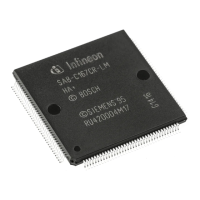AP29000
Connecting C166 and C500 Microcontroller to CAN
Examples for the Connection of Infineon Microcontrollers to CAN
Application Note 34 V 1.0, 2004-02
5 Examples for the Connection of Infineon
Microcontrollers to CAN
5.1 Connecting the C167CR / C515C to CAN
Figure 13 shows the connection between the C167CR and the CAN bus. The CAN
module is connected to the outside world via two pins, CAN_RxD (P4.5) and
CAN_TxD, of port 4. CAN_RxD receives data from the physical layer of the CAN bus,
while CAN_TxD transfers data to the physical layer. The physical layer is not
implemented in the CAN module, so the C167CR is likewise connected via an external
transceiver to the CAN bus lines CAN_H and CAN_L. In this example, the CAN bus is
a shielded, twisted wire pair with termination resistors at both ends of the bus lines. If
the transceiver has an input pin for slope control or "stand-by", it can be driven via a
port pin of the C167CR (pin P4.7 in this case).
Notes:
• If the CAN module is used, port 4 may not be programmed to output all eight
segment address lines. A maximum of four segment address lines is possible in this
case. The address range that can be accessed via the address lines is then reduced
to 1 MByte.
• P4.5 (CAN_RxD) has to be configured as input by the user. (If the CAN module is
not used, P4.5 can be used as general purpose I/O).
• In some versions / production steps of the C167CR, CAN_TxD is configured as
output by hardware and therefore cannot be used as general purpose I/O pin P4.6.
Please contact your distributor or your local Infineon office if you need further
information about this subject.

